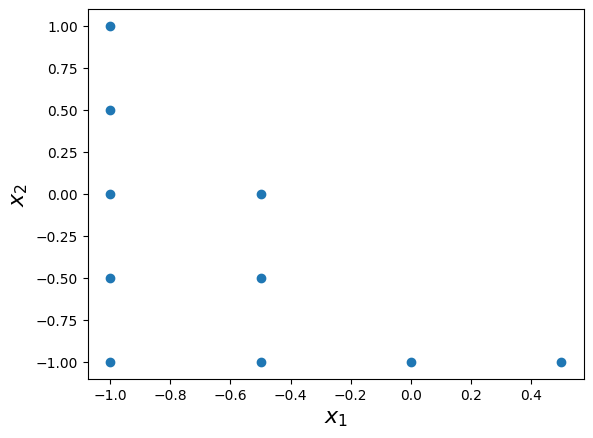Create a Grid with a Generating Function#
import numpy as np
import minterpy as mp
import matplotlib.pyplot as plt
Minterpy interpolating polynomials (i.e., in the Lagrange or Newton basis) lives on a grid that holds the so-called unisolvent nodes. An interpolating multi-dimensional polynomial of a given multi-index set of exponents is uniquely determined on the corresponding unisolvent nodes.
An instance of Grid can be constructed via different constructors:
Grid.from_function(): create an instance with a generating function (this page)Grid.from_points(): create an instance with an array of generating points (see the example)Grid.from_degree(): create an instance with a complete multi-index set (see the example)Grid.from_value_set(): create an instance based on an array of generating values (see the example)
This guide provides an example on how to construct a Grid instance based
on a given generating function using the from_function() method.
About a generating function#
A generating function is a function that creates an array of generating points
(nodes) for a given one-dimensional polynomial degree and spatial dimension.
It then returns an array of shape (n + 1, m) where n and m are the
one-dimensional polynomial degree and spatial dimension, respectively.
A valid generating function in Minterpy must have a signature similar to the one below:
def my_gen_fun(poly_degree: int, spatial_dimension: int) -> np.ndarray:
...
It must return an array with the aforementioned shape and each column of the array must have unique values.
Take for instance, the default generating function in Minterpy, i.e., the Leja-ordered Chebyshev-Lobatto generating function. The function returns the following generating points in two dimensions with maximum polynomial degree of \(3\) in every dimension:
mp.gen_points.gen_points_chebyshev(poly_degree=3, spatial_dimension=2)
array([[ 1. , -1. ],
[-1. , 1. ],
[ 0.5, -0.5],
[-0.5, 0.5]])
Notice that the array has \(4\) rows (i.e., \(n + 1\), \(n = 3\) as one-dimensional polynomials of degree \(3\) require \(4\) points) and \(2\) columns (i.e., \(m = 2\)), and that each column has unique values.
About the from_function() factory method#
The method from_function() of the Grid class returns an instance of Grid
based on a given generating function.
The method accepts two mandatory arguments, namely, the multi-index set of exponents that defines the polynomials that grid can support, and the generating function that creates generating points as required by the multi-index set.
Any callable that is a valid generating function (see above) may be passed
as the second argument to from_function().
Alternatively, a string as a key to a dictionary of built-in generating
functions may be specified.
The from_function() method is a shortcut to create a grid with a given
multi-index set and a particular generating function that is, possibly, defined
by the users.
Example: Two-dimensional interpolation grid#
Create an equidistant interpolation grid in \([-1, 1]^2\) to support two-dimensional polynomials having a multi-index set \(A = \{ (0, 0), (1, 0), (2, 0), (3, 0), (0, 1), (1, 1), (0, 2), (1, 2), (0, 3), (0, 4) \}\) (defined with respect to \(l_p\)-degree \(2.0\)).
Multi-index set#
Create an instance of MultiIndexSet following the above specification:
exponents = np.array([
[0, 0],
[1, 0],
[2, 0],
[3, 0],
[0, 1],
[1, 1],
[0, 2],
[1, 2],
[0, 3],
[0, 4],
])
mi = mp.MultiIndexSet(exponents, lp_degree=2.0)
print(mi)
MultiIndexSet(m=2, n=4, p=2.0)
[[0 0]
[1 0]
[2 0]
[3 0]
[0 1]
[1 1]
[0 2]
[1 2]
[0 3]
[0 4]]
Generating function#
The generating function for equidistant points can be defined as follows:
def equidistant_gen_function(
poly_degree: int,
spatial_dimension: int,
) -> np.ndarray:
"""Create an array of equidistant generating points."""
xx = np.linspace(-1, 1, poly_degree + 1)[:, np.newaxis]
return np.tile(xx, spatial_dimension)
Given the function above, the generating points for polynomial degree \(3\) in every dimension and spatial dimension \(3\) are:
print(equidistant_gen_function(3, 3))
[[-1. -1. -1. ]
[-0.33333333 -0.33333333 -0.33333333]
[ 0.33333333 0.33333333 0.33333333]
[ 1. 1. 1. ]]
Grid instance#
Given the multi-index set and the generating function,
an instance of Grid can be constructed via the from_function() method
as follows:
grd = mp.Grid.from_function(mi, equidistant_gen_function)
The grid has the following unisolvent nodes:
print(grd.unisolvent_nodes)
[[-1. -1. ]
[-0.5 -1. ]
[ 0. -1. ]
[ 0.5 -1. ]
[-1. -0.5]
[-0.5 -0.5]
[-1. 0. ]
[-0.5 0. ]
[-1. 0.5]
[-1. 1. ]]
Finally, the two-dimensional interpolation grid is plotted below:
plt.scatter(grd.unisolvent_nodes[:, 0], grd.unisolvent_nodes[:, 1])
plt.xlabel("$x_1$", fontsize=16)
plt.ylabel("$x_2$", fontsize=16);

